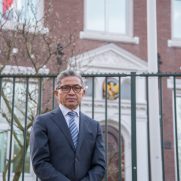Map of Indonesia © Google Maps 2015
Profile of Indonesia
Indonesia is the world’s largest archipelago, comprising over 17,500 islands (6.000 inhabited) and 54.000 km coastline. The country stretches around the equator for 5,150 km (3,200 miles) – roughly the distance between Los Angeles and New York or Northern Ireland and the Caucasus.
Seas and oceans comprise 81% of the total area of the Republic. Five main islands and 30 smaller archipelagos are home to the majority of the population, consisting of roughly 300 ethnicities. The main islands are Kalimantan, Sumatra, Irian Jaya, Sulawesi and Java. Java alone is home to roughly 70 per cent of the country’s population, which amounts to over 250 million – of which almost half is under the age of 24.
Indonesia shares the island of Papua with Papua New Guinea and the island of Kalimantan with Malaysia and Brunei Darussalam.
Across the country, the land is generally covered by thick tropical rain forests, where fertile soil is continuously replenished by volcanic eruptions like those on the island of Java. But Indonesia is also mountainous, with some 400 volcanoes, of which 100 are still active.
Indonesia is strategically located between the Indian and Pacific Ocean and the China Sea, astride vital sea lanes in Southeast Asia. Because of its geographic location Indonesia is critical to regional stability and progress in Southeast Asia.
Indonesia is a prominent member of ASEAN and member of the G20.
Having a GDP size of over US$ 1 trillion in 2014, Indonesia is the largest economy in Southeast Asia. Much less affected by the global financial crisis than its neighboring countries, Indonesia’s economy grew by 5.8% in 2013, 5.01% in Q3 2014 and is expected to reach 5.1-5.5 % in 2014. Indonesia has the second highest economic growth among the G-20 economies. Future economic expansion is expected to include more inclusive growth as nominal per-capita GDP is expected to quadruple by 2020, according to Standard Chartered. McKinsey projected Indonesia will be the 7th largest economy in the world by 2030.
A large part of Indonesian economic success is a result of prudent fiscal stewardship that focused on reducing the debt burden. Indonesia’s debt to GDP ratio has steadily declined from 83% in 2001 to 26.2% in 2013; the lowest among ASEAN countries, aside from Singapore which has no government debt.
As a result, by December 2013, Moody’s improved Indonesia’s credit rating to Baa3 (stable) while Standard & Poor’s put Indonesia on BB+ (stable) by April 2014 and Fitch put Indonesian rating to BBB- (stable) by November 2014. Thus the three rating agencies put Indonesia on investment grade status. The rating reflected Indonesia’s resilience to the global financial crisis, improving government and external credit-metrics, and an ability to manage domestic political challenges to the reform agenda.
These achievements have increased the frequency with which Indonesia is being compared to middle-income developing nations like Brazil, India and Mexico. Economically strong, politically stable, reform minded, Indonesia is an emerging global powerhouse in Asia.
Indonesia is the world’s third largest democracy. Its capital, Jakarta, is the world’s 5th metropolis. Indonesia begun its successful transition from authoritarian to democratic governance in 1998, strengthened by free and fair elections. Since 2001, as a result of decentralized government, regional centers gained newly rising influence.
Indonesia exhibits the dynamics of a growing democracy. This has brought the country macroeconomic stability, a lively and assertive parliament, and progress on professional reform including the military and police forces.
With the world’s largest Muslim population, Indonesia is yet one of the few Muslim-majority* nations in which Islam is not the state religion. In its preamble, the 1945 constitution sets forth the Pancasila as the embodiment of basic principles of an independent Indonesian state. These five principles, announced by Sukarno, are: belief in one supreme God; humanitarianism; nationalism expressed in the unity of Indonesia; consultative democracy; and social justice. The constitution of Indonesia is demonstrating that democracy and Islam are compatible, and is a voice of moderation in the Islamic community.
*The population consists of 87% Muslim, 10% Christian and ca. 2% Hindu
Indonesia is the largest economy in Southeast Asia. Much less affected by the global financial crisis than its neighboring countries, Indonesia’s economy grew by 5.8% in 2013, 5.01% in Q3 2014 and is expected to reach 5.1-5.5 % in 2014. Indonesia has the second highest economic growth among the G-20 economies. Future economic expansion is expected to include more inclusive growth as nominal per-capita GDP is expected to quadruple by 2020, according to Standard Chartered. McKinsey projected Indonesia will be the 7th largest economy in the world by 2030.
A large part of Indonesian economic success is a result of prudent fiscal stewardship that focused on reducing the debt burden. Indonesia’s debt to GDP ratio has steadily declined from 83% in 2001 to 26.2% in 2013; the lowest among ASEAN countries, aside from Singapore which has no government debt. As a result, the three rating agencies put Indonesia on investment grade status. The rating reflected Indonesia’s resilience to the global financial crisis, improving government and external credit-metrics, and an ability to manage domestic political challenges to the reform agenda.
Economically strong, politically stable, reform minded, Indonesia is an emerging global powerhouse in Asia.
The Netherlands is de second biggest EU trading partner to Indonesia, after Germany. The export of Indonesia to the Netherlands amounts to € 2.7 billion, whereas Indonesia imports to the amount of € 800 million from the Netherlands (trade figures 2014). The FDI (Foreign Direct Investments) of the Netherlands in Indonesia amounts to 1.7 billion US dollar, ranked 4th.
History
The History of Indonesia was shaped by its geographic position, its natural resources, the series of human migrations, contacts, economy and trade, conquests and politics.
Peoples of various migrations, creating a diversity of cultures, ethnicities, and languages, populate the area of Indonesia. The archipelago’s landforms and climate significantly influenced agriculture and trade.
Fossilised remains of Homo erectus and his tools, popularly known as the ‘Java Man’, suggest the Indonesian archipelago was inhabited by at least 1.5 million years ago.
Austronesian people, who form the majority of the modern population, are thought to have originally been from Taiwan and arrived in Indonesia around 2000 BCE.
From the 7th century CE, the powerful Srivijaya naval kingdom flourished bringing Hindu and Buddhist influences with it. The agricultural Buddhist Sailendra and Hindu Mataram dynasties subsequently thrived and declined in inland Java.
The last significant non-Muslim kingdom, the Hindu Majapahit kingdom, flourished from the late 13th century, and its influence stretched over much of Indonesia.
The earliest evidence of Islamised populations in Indonesia dates to the 13th century in northern Sumatra; other Indonesian areas gradually adopted Islam which became the dominant religion in Java and Sumatra by the end of the 16th century. For the most part, Islam overlaid and mixed with existing cultural and religious influences.
Europeans arrived in Indonesia from the 16th century seeking to monopolise the sources of valuable nutmeg, cloves, and cubeb pepper in Maluku. In 1602 the Dutch established the Dutch East India Company (VOC) and became the dominant European power.
Following bankruptcy, the VOC was formally dissolved in 1800, and the government of the Netherlands established the Dutch East Indies as a nationalised colony. By the early 20th century Dutch dominance extended to what was to become Indonesia’s current boundaries.
The Japanese invasion and subsequent occupation during WWII ended Dutch rule, and encouraged the previously suppressed Indonesian independence movement. Two days after the surrender of Japan in August 1945, nationalist leader, Sukarno, declared independence and was appointed president.
The Netherlands tried to re-establish their rule, but a bitter armed and diplomatic struggle ended in December 1949, when in the face of international pressure, the Dutch formally recognised Indonesian independence.
An attempted coup in 1965 led to a violent army-led anti-communist purge in which over half a million people were killed. General Suharto politically out-manoeuvred President Sukarno, and was formally appointed president in March 1968. His New Order administration garnered the favour of the West whose investment in Indonesia was a major factor in the subsequent three decades of substantial economic growth.
In the late 1990s, however, Indonesia was the country hardest hit by the East Asian Financial Crisis, which led to popular protests and Suharto’s resignation on 21 May 1998.
The Reformasi era following Suharto’s resignation, has led to a strengthening of democratic processes, including a regional autonomy program, the secession of East Timor, and the first direct presidential election in 2004.
Indonesia is now the world’s third most populous democracy, the world’s largest archipelagic state, and home to the world’s largest Muslim population.
For more country information contact the Embassy of the Republic of Indonesia.Telephone+31(070)3108100
Website: https://en.indonesia.nl
Indonesia extra links:
http://www.usindo.org
http:/www.worldbank.org/en/country/indonesia





